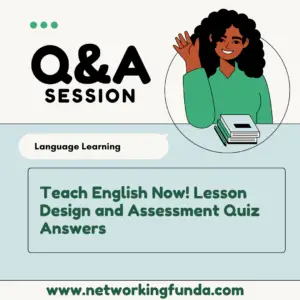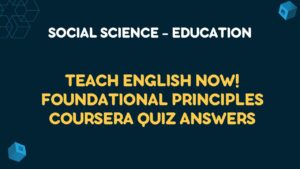All Weeks Introduction to Intellectual Property Coursera Quiz Answers
Table of Contents
Introduction to Intellectual Property Week 01 Quiz Answers
Quiz 1: Patent Quiz Answers
Q1. The term of a patent is:
- Lifetime of the inventor plus 70 years
- As long as the patent is used in commerce
- 20 years
- 56 years
Q2. True or False: All appeals of patent law cases are handled by one US Court of Appeals.
- True
- False
Quiz 2: Trademarks Quiz
Q1. Trademarks must:
- Be novel
- Establish an association with a good
- Express an original idea
Q2. You can lose trademark protection if:
- The term of the trademark expires
- Someone copies your trademark
- You use the trademark so much that it becomes generic
Quiz 3: Copyrights Quiz
Q1. Copyright protection extends to:
- New methods or processes
- Literary or musical works
- Source identifiers
Q2. To get a copyright you must:
- Register the mark with the copyright office
- Apply for the copyright with the copyright office and go through an examination process
- Do nothing; the copyright vests automatically upon fixation of the work
Module 1 Quiz Answers
Q1. In order to get a patent, you must show that the invention is:
- Non-obvious
- Independently created expression
- A source identifier
- Fixed in a tangible medium of expression
Q2. Which of the following protects movies?
- Patents
- Copyright
- Trademarks
- Trade secrets
Q3. What must you do in order to protect a trade secret?
- Register your trade secret with the US Trade Secret Registry
- Take precautions to keep the information secret
- Nothing: trade secret protection is automatic as soon as the secret is generated
Q4. How long does trademark protection last?
- 20 years
- 70 years
- Potentially forever
Introduction to Intellectual Property Week 02 Quiz Answers
Quiz 1: IP Theories
Q1. Which of the following theories of intellectual property rights is considered to be most influential on our modern understanding of IP rights?
- Natural Rights Theory
- Personhood Theory
- Utilitarian Theory
Quiz 2: Costs of IP
Q1. One cost of intellectual property rights is:
- The rights holders do not get a pure monopoly
- There are fewer goods shipped and purchased because rights holders can charge higher prices.
- The quality of goods is lower
Module 2 Quiz Answers
Q1. Which theory predominantly provides the basis for intellectual property rights in the United States?
- Game Theory
- Utilitarian Theory
- First Possession Theory
Q2. The utilitarian end goal of the incentives provided by patent and copyright law is:
- To promote the most competitive free market possible.
- To encourage the creation of more inventions and creative works.
- To maximize the rewards for inventors and creators.
Q3. True or False: Intellectual property rights are a public good
- True
- False
Q4. IP rights lead to which of the following?
- Monopoly pricing
- Competitive pricing
- Pricing between a monopoly and competitive pricing
Q5. Which of the following is a potential cost of IP rights?
- Using IP rights to hinder future innovation
- Fewer creative works produced
- Proliferation of trade secrets being protected by private parties
Introduction to Intellectual Property Week 03 Quiz Answers
Quiz 1: Patent Law Alternatives
Q1. Which of the following is a con to having no patent system?
- Diminished incentives to invent
- High screening costs
- Return to competitive market pricing
Q2. Benefits of trade secrecy include:
- Lower costs than a patent system.
- Eliminating disclosure benefits
- Creating risk for rights holders
Quiz 2: Copyright Law Alternatives
Q1. True or False: Eliminating the copyright system would limit the people who could afford to produce creative works.
- True
- False
Q2. True or False: Encryption and technological protections can provide protection without legal enforcement.
- True
- False
Q3. True or False: Encryption and technological protections have no risk of being circumvented.
- True
- False
Module 3 Quiz Answers
Q1. Government contracts and grants are beneficial because:
- They require the government to pick winners
- They require government to pay out to inventors
- There are little to no monopolization costs
- They centralize innovation decisions.
Q2. Which of the following is NOT an alternative to patent law for incentivizing inventions?
- Tax policies and credits
- Copyright Law
- Utility models
- Prizes and Grants
Q3. True or False: Private subscription services sometimes force artists to be able to attract subscribers, which may force them to be more entrepreneurial, but may also prevent them making all manner of works.
- True
- False
Q4. Tradition and industry norms do NOT:
- Create strong incentives for people to abide by those traditions
- Create barriers to entry
- Create long term guarantees of stability
Introduction to Intellectual Property Week 04 Quiz Answers
Q1. True or False: Patents are the most expensive form of IP to obtain
- True
- False
Q2. True or False: Copyrights provide the broadest protection
- True
- False
Q3. Trademarks have the longest period of protection of IP rights
- True
- False
Get All Course Quiz Answers of Intellectual Property Law Specialization
Introduction to Intellectual Property Coursera Quiz Answers
Copyright Law Coursera Quiz Answers
Trademark Law Coursera Quiz Answers
Patent Law Coursera Quiz Answers



